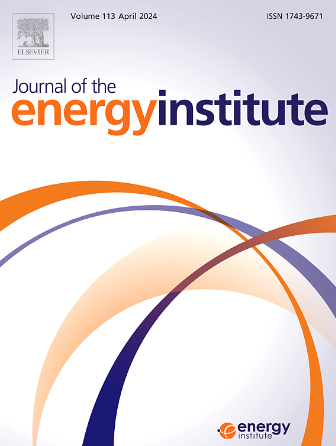NiO/ Y型沸石催化高压热解聚丙烯制氢:压力和甲烷化反应的影响
IF 6.2
2区 工程技术
Q2 ENERGY & FUELS
引用次数: 0
摘要
研究了在不同压力条件下,用nio负载催化剂催化裂解聚丙烯制氢。实验在500-800℃、0.1-2 MPa下进行。热重分析表明,中等压力抑制了挥发性物质的释放,从而延缓了降解,而较高的压力则加速了热裂解和二次反应。气体分析表明,H2和CH4产率随压力的增加而增加,由于甲烷化有利,CH4占主导地位。NiO/Al2O3促进了烃裂解,但对CH4转化的影响有限。相比之下,NiO/ Y分子筛显著提高了H2产率,抑制了CH4的积累,特别是在800℃和2 MPa下。这是由于其比表面积大,酸性强,有利于重整和反甲烷化。这些发现强调了压力和催化剂组成对热解行为和产物分布的综合影响,为优化塑料废物的富氢气体生产提供了见解。本文章由计算机程序翻译,如有差异,请以英文原文为准。
Enhanced hydrogen production from polypropylene via NiO/Zeolite Y catalyzed high-pressure pyrolysis: Effects of pressure and methanation reactions
This study investigated the catalytic pyrolysis of polypropylene for hydrogen production using NiO-supported catalysts under varying pressure conditions. Experiments were conducted at 500–800 °C and 0.1–2 MPa. Thermogravimetric analysis revealed that moderate pressures delayed degradation owing to suppressed volatile release, whereas higher pressures accelerated thermal cracking and secondary reactions. Gas analysis indicated increased H2 and CH4 yields with increasing pressure, with CH4 becoming dominant owing to favorable methanation. NiO/Al2O3 promoted hydrocarbon cracking but had a limited impact on CH4 conversion. In contrast, NiO/Zeolite Y significantly improved the H2 yield and suppressed CH4 accumulation—particularly at 800 °C and 2 MPa. This was attributed to its large surface area and strong acidity, which enhanced reforming and reverse methanation. These findings highlight the combined influence of pressure and catalyst composition on the pyrolysis behavior and product distribution, offering insights for optimizing hydrogen-rich gas production from plastic waste.
求助全文
通过发布文献求助,成功后即可免费获取论文全文。
去求助
来源期刊

Journal of The Energy Institute
工程技术-能源与燃料
CiteScore
10.60
自引率
5.30%
发文量
166
审稿时长
16 days
期刊介绍:
The Journal of the Energy Institute provides peer reviewed coverage of original high quality research on energy, engineering and technology.The coverage is broad and the main areas of interest include:
Combustion engineering and associated technologies; process heating; power generation; engines and propulsion; emissions and environmental pollution control; clean coal technologies; carbon abatement technologies
Emissions and environmental pollution control; safety and hazards;
Clean coal technologies; carbon abatement technologies, including carbon capture and storage, CCS;
Petroleum engineering and fuel quality, including storage and transport
Alternative energy sources; biomass utilisation and biomass conversion technologies; energy from waste, incineration and recycling
Energy conversion, energy recovery and energy efficiency; space heating, fuel cells, heat pumps and cooling systems
Energy storage
The journal''s coverage reflects changes in energy technology that result from the transition to more efficient energy production and end use together with reduced carbon emission.
 求助内容:
求助内容: 应助结果提醒方式:
应助结果提醒方式:


